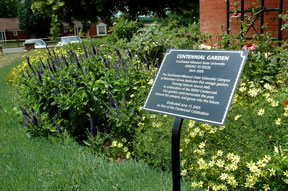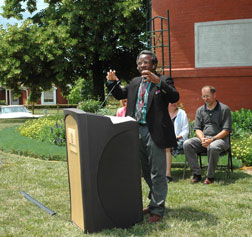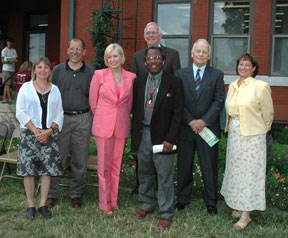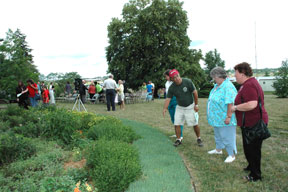Centennial Garden Dedication
The Centennial Garden, prepared and planted in 2003 and 2004, was dedicated on June 17, 2005 as part of the Missouri State University Centennial Celebration. The garden frames Faurot Hall, the original administration building of the State Fruit Experiment Station listed on the National Register of Historic Places. Dr. Inno Onwueme, Associate Dean of the School of Agricultural Sciences and Head of the Fruit Science Department (photo right), welcomed everyone and introduced those on the program as the Master of Ceremonies. Dr. Jeanne Phelps and Dr. Earle Doman of the Centennial Steering Committee talked about garden project and Patrick Byers, Fruit Grower Advisor, recounted the history of the State Fruit Experiment Station from its establishment in 1899. Marilyn Odneal spoke about the garden research and implementation and was followed by Mary Armstrong of the Mountain Grove Chamber of Commerce who commented on the role the Mountain Grove Campus has in the community and shared a Chinese Proverb with the group: "If you are planning for a year, sow rice. If you are planning for a decade, plant a tree. If you are planning for a lifetime, educate people."
Dr. Keiser, president of Missouri State, related the garden to the whole campus and then unveiled the dedication plaque with Mary Sheid, vice president of the Board of Governors, who read the dedication. (Group photo left includes the speakers from left to right Marilyn Odneal, Patrick Byers, Mary Sheid, Inno Onwueme, Earle Doman (back), John Keiser, and Jeanne Phelps.)
Earle Doman mentioned in his address that his grandmother, who was born in the 1890s, advised him not to set plants close to the foundation of his and his wifes’ first home so "it could breathe". He thought this was odd until he learned that doctors in the mid-1800s advised against placing plants against the foundation of the house as it would promote diseases like tuberculosis, and this was probably why his grandmother so advised him. Only a few vines were allowed to be planted up against the house in those days (Koziol 2004). Foundation plantings, therefore, were relatively new during the post-Victorian era, and were recommended as a way to "settle" the house in its grounds.
Our approach to the Centennial Garden was to "make a new layer" (Adams, 2004), that is, we represented the original foundation planting with bridal wreath spirea and vines as in the very early photos of Faurot Hall, but increased the number and diversity of the plants to enhance the educational value of the garden.
All of the plants used were popular in American gardens of the early 1900s (Favretti, 1978). Older cultivars as well as newer cultivars of old-fashioned plants are incorporated. Purple coneflower is used to signify the strong movement to use native plants in gardens in the period. New Dawn rose, climbing over the arbor, was the first plant to receive a patent in 1931.
(The two photos at the right depict the crowd including (upper) Tri-County Master Gardener volunteers enjoying the nice weather on garden dedication day and (lower) Dallas Dawson discussing the pruning of dianthus 'Bath's Pink' with some interested participants.)
The research conducted on American garden history involved examining early 1900s photographs of Faurot Hall from the Fruit Station archives housed in the Paul Evans Library of Fruit Science. Garden Magazines of the period were also used and proved to be the most valuable source of information on the period. "Magazines published between the turn of the century and World War II preserve an important heritage of American garden writing and provide a remarkable record of our largely forgotten past achievements as a nation of amateur gardeners. This flourishing era of garden writing began just as broad-circulation magazines were becoming our first national medium of mass communication . . .and were the leading force in establishing a dominant popular culture extending through all social classes and geographical regions of the United States." (Clayton, 2000)
The weather cooperated and the dedication was followed by a mini-open house of the campus buildings and grounds. President Keiser (photo left) commented in his address that "This entire campus is a garden. The Centennial Garden focuses on that."
References
Landscapes and Gardens for Historic Buildings; A handbook for reproducing and creating authentic landscape settings. (1978) 2nd ed. revised 1997. R. J. Favretti and J. P. Favretti. Altamira Press. 201 pp.
A Midwestern Garden. 2004. Presentation by Nina Koziol at The Midwest Gardening Symposium, March 19-21, Thornhill Education Center, Lisle, Illinois.
The Once and Future Gardener: Garden Writing from the Golden Age of Magazines 1900-1940. 2000. Virginia Tuttle Clayton. David R. Godine Publisher. 312 pp.
Restoring American Gardens: An encyclopedia of heirloom ornamental plants 1640 - 1940. 2004. Denise Wiles Adams. Timber Press. 419 pp.





